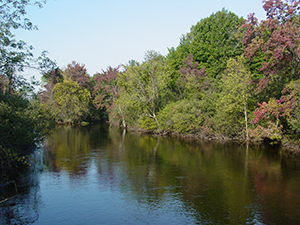 Purdue University - Extension - Forestry and Natural Resources
Purdue University - Extension - Forestry and Natural Resources
Got Nature? Blog
 While we are awaiting the color change and dropping of leaves in October, it is also a good time to think about planting trees next spring. Indiana landowners have access to low-cost and high-quality seedlings through the state forest nurseries operated by the Indiana Department of Natural Resources Division of Forestry. The state nurseries began taking orders for seedlings available for planting next spring on October 1, and orders will be accepted until next spring or when all stock is sold. Ordering early is encouraged as demand for seedlings can be high.
While we are awaiting the color change and dropping of leaves in October, it is also a good time to think about planting trees next spring. Indiana landowners have access to low-cost and high-quality seedlings through the state forest nurseries operated by the Indiana Department of Natural Resources Division of Forestry. The state nurseries began taking orders for seedlings available for planting next spring on October 1, and orders will be accepted until next spring or when all stock is sold. Ordering early is encouraged as demand for seedlings can be high.
Seedlings of many different deciduous and evergreen tree and shrub species useful for forest and wildlife management, windbreak establishment and erosion control are available for purchase. Seedlings are mostly one to three years old and are sold as bare-root stock packaged in moist sphagnum moss and wrapped into bales using special packaging paper. Landowners can order individual tree species in multiples of 100 or several multi-species packages aimed at different purposes like wildlife habitat or native tree nut production. The state nursery seedlings are sold for conservation planting purposes and are not to be resold or used for Christmas tree or landscape plantings. Private nurseries in Indiana and neighboring states can supply seedlings for these purposes. You can access the state nursery tree sales at Tree Seedlings Ordering Instructions.
Planting site research and preparation this fall to prepare for planting next spring will increase your chances for a successful planting. Learn what soils are present on your planting site by using the online tool, the Web Soil Survey. This soil mapping and information tool helps you discover what soils are located on your land, prepare soil maps and explore the capacity of your soils for growing trees, shrubs and crops as well as their suitability for a variety of activities including ponds and construction. The Web Soil Survey tool is provided by the USDA Natural Resources Conservation Service.
Controlling competing grasses, weeds and brush where you plan to plant seedlings can increase survival and growth. Perennial plants can be controlled in the summer or fall to prepare the site for spring planting. Herbicides, tillage or other mechanical or cultural treatments can be used to control these competing plants and give your planted seedlings the best chance for success. Deer can also pose a danger to your seedlings by their browsing and antler-rubbing. Fencing, shelters or repellants may be needed to protect the seedlings until they are large enough to resist browsing or antler damage.
Resources
Hardwood Seedling Production/Propagation (click Publications, then Research Publications), Hardwood Tree Improvement and Regeneration Center
Planting Forest Trees and Shrubs in Indiana, The Education Store
Tree Seedling Nurseries, Indiana Department of Natural Resources
Lenny D. Farlee, Extension Forester
Hardwood Tree Improvement and Regeneration Center
Forestry and Natural Resources, Purdue University

Recent Posts
- A Woodland Management Moment: Black Walnut in Pine Plantation
Posted: December 19, 2025 in Forestry, Forests and Street Trees, Urban Forestry, Woodlands - ID That Tree: Sugarberry
Posted: December 12, 2025 in Forestry, Wildlife, Woodlands - Powering Rural Futures: Purdue’s Agrivoltaics Initiative for Sustainable Growth
Posted: December 9, 2025 in Community Development, Wildlife - Learn How to Control Reed Canarygrass
Posted: December 8, 2025 in Forestry, Invasive Plant Species, Wildlife - Benefits of a Real Christmas Tree, Hoosier Ag Today Podcast
Posted: December 5, 2025 in Christmas Trees, Forestry, Woodlands - Succession Planning Resource: Secure your Future
Posted: December 2, 2025 in Community Development, Land Use, Woodlands - A Woodland Management Moment: Butternut Disease and Breeding
Posted: December 1, 2025 in Forestry, Forests and Street Trees, Woodland Management Moment, Woodlands - Controlling Introduced Cool-Season Grasses
Posted: in Forestry, Invasive Plant Species, Wildlife - Red in Winter – What Are Those Red Fruits I See?
Posted: in Forestry, Plants, Urban Forestry, Wildlife, Woodlands - Managing Common and Cut Leaved Teasel
Posted: November 24, 2025 in Forestry, Invasive Plant Species, Wildlife
Archives
Categories
- Alert
- Aquaculture/Fish
- Aquatic/Aquaculture Resources
- Ask the Expert
- Christmas Trees
- Community Development
- Disease
- Drought
- Forestry
- Forests and Street Trees
- Gardening
- Got Nature for Kids
- Great Lakes
- How To
- Invasive Animal Species
- Invasive Insects
- Invasive Plant Species
- Land Use
- Natural Resource Planning
- Nature of Teaching
- Plants
- Podcasts
- Ponds
- Publication
- Safety
- Spiders
- Timber Marketing
- Uncategorized
- Urban Forestry
- Webinar
- Wildlife
- Wood Products/Manufacturing
- Woodland Management Moment
- Woodlands